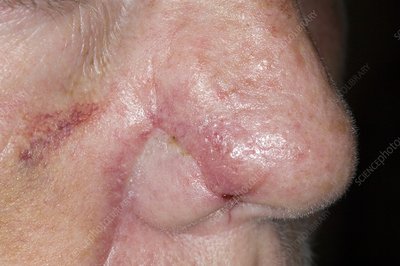
The first basal cell carcinoma symptoms include a shiny bump on the skin. The lump may be clear, pearly, pink, or tan or brown. About 50% of all basal cell cancers are pigmented. If the bump is red, it may be crusted or painful. A dermatologist can determine whether the bump is a sign of BCC and what treatments are appropriate. Patients should visit a dermatologist for further evaluation.
Your doctor may prescribe a medicated cream that acts like a chemotherapy drug. This type of treatment is used to shrink the tumor and minimize its size. It will also kill any cancer cells left in the skin. In some cases, medicated creams are the only treatment, although a more aggressive approach is also possible. In some cases, radiation therapy may be an option. For more advanced basal cell carcinoma, a doctor may recommend surgery.
The main symptoms of basal cell carcinoma are pain, itching, and redness. They may be accompanied by many other symptoms. You should take note of the main questions you want your doctor to answer. If you have additional questions, feel free to ask and get advice on the site https://palermo-store.it/. If you notice any of these symptoms, contact your dermatologist immediately. It is very important to make the correct diagnosis as early as possible.
Typically, basal cell carcinoma does not spread to other parts of the body. However, it can spread to the lymph nodes. Symptoms of basal cell carcinoma include an ulcer that does not heal, skin changes, and swelling in the skin that looks different than elsewhere on the body. It can be white or red, hard or waxy to the touch. If it is invasive, it may spread to other parts of the body.
A basal cell carcinoma tumor begins as a small, shiny bump that does not spread. These tumors are often present in areas exposed to the sun. Early signs of basal cell carcinoma are usually subtle, but if the tumor has spread, it can be treated. As a result, it may be difficult for you to identify it. The bump can be white or red and hard. This may be a sign of basal cell carcinoma.
The symptoms of basal cell carcinoma are not specific to a particular type of cancer. However, they can be mistaken for other skin conditions. Therefore, you should consult a dermatologist if you notice a bump on your skin. Your doctor will be able to distinguish basal cell carcinoma from other types of cancer. There are many signs of basal cell carcinoma. If you notice a lump, see a dermatologist for an evaluation and visit the health website sagreinbasilicata.com.
Basal cell carcinoma may present as a shiny pink lump with a raised center. Over time, a small blood vessel may develop in the center of the tumor. It may be waxy or flat white and have jagged edges. If the tumor is invasive, a scar may remain. It can also affect the shape of the face. This type of cancer can be diagnosed early, before the cancer has spread to other parts of the body.
Although basal cell carcinoma is usually found on areas of the body that are exposed to the sun, it can also appear in areas that have never been exposed to the sun. Although basal cell carcinoma does not require an urgent referral, it is important to see a dermatologist within 18 weeks of the onset of symptoms. If the tumor is a basal cell carcinoma, the doctor will do a biopsy to confirm the diagnosis. The doctor will remove some of the skin to make sure the cancer is not cancerous.
If you notice a bump on your skin, you may have basal cell carcinoma. The bump will be red and shiny. If it is pink, it will be crusted or irritated. It may also crust or turn into an ulcer. If left untreated, it can spread to other parts of the body. But CCC rarely spreads to other parts of the body. Its symptoms are not always obvious.